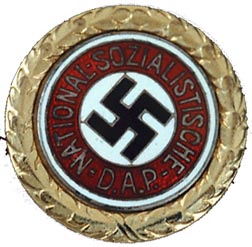
Fortunately, these new and convincing fakes have several subtle flaws. Examine the photos below to see how they vary from genuine badges.
1. Large Deschler Badge
The large Deschler badge has at least four distinguishing features from a genuine badge - two on the front and two on the reverse. The fake badge is the same dimensions as a real one, and the lettering and finish is very close as well.
The first difference is the enamel. On genuine badges it is translucent like red glass. These fakes have red enamel that is more opaque, although the next generation of these badges now circulating have corrected this. There is a correct number of oak leaves, and the only difference is the fake has a more pronounced center ridge. It is more evident in an artificially aged piece like below than in a shiny one, like on the preceding page. Genuine Gold Party Badges do not corrode in the same way as artificially aged badges. Gold is very resistant to tarnish, and artificial aging of fakes often leaves them with exaggerated black or green patches.
The reverse of the
fake large Deschler badge is also done to deceive. The pin-plate attachment
is better than most. The "GES. GESCH." mark is in convincing
characters. Fortunately the reverse has at least one and sometimes two
flaws.
The pinplate is not correct for a Deschler badge - specifically, the bottom edge is too straight and the lettering of the maker name is close but not quite right. These new fakes do not use the proper number font common to Deschler badges. The pictured example shows numbers that are slightly too tall and narrow. Impressed member numbers on large Deschler badges are fatter and more rounded.
A close-up
shows another problem with the numbers. Impressed numbers on Deschler badges do not use a flat-topped "3" as shown,
and the "4" should be open at the top and not closed. (NOTE:
There is a genuine variation that uses what is known as "rotograving"
to engrave numbers on large Deschler badges. These do typically use a
flat-topped "3" and a closed "4". It is not found
as often as impressed numbers on genuine badges, and can be identified
as genuine by the existence of small swirls inside the engraved numbers
from the engraving tool.)